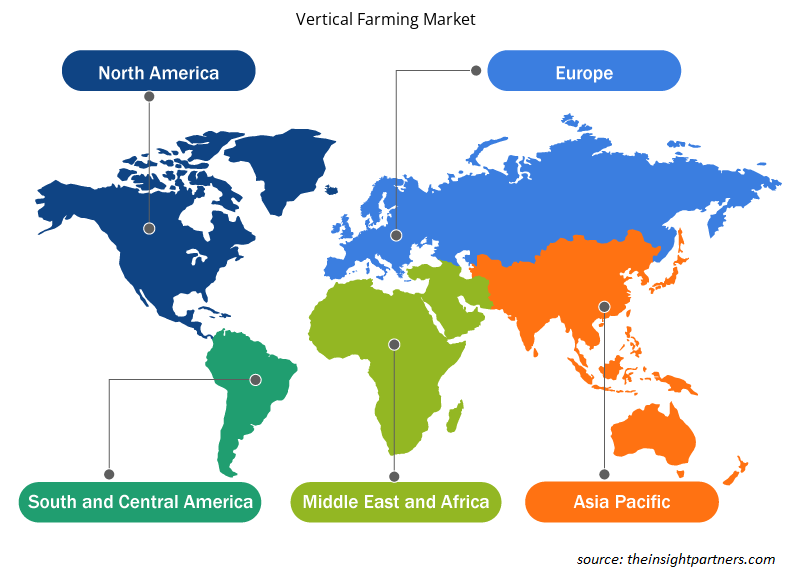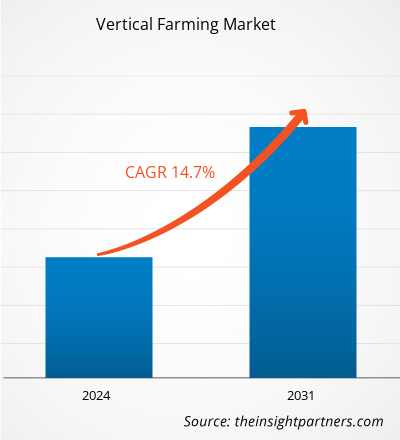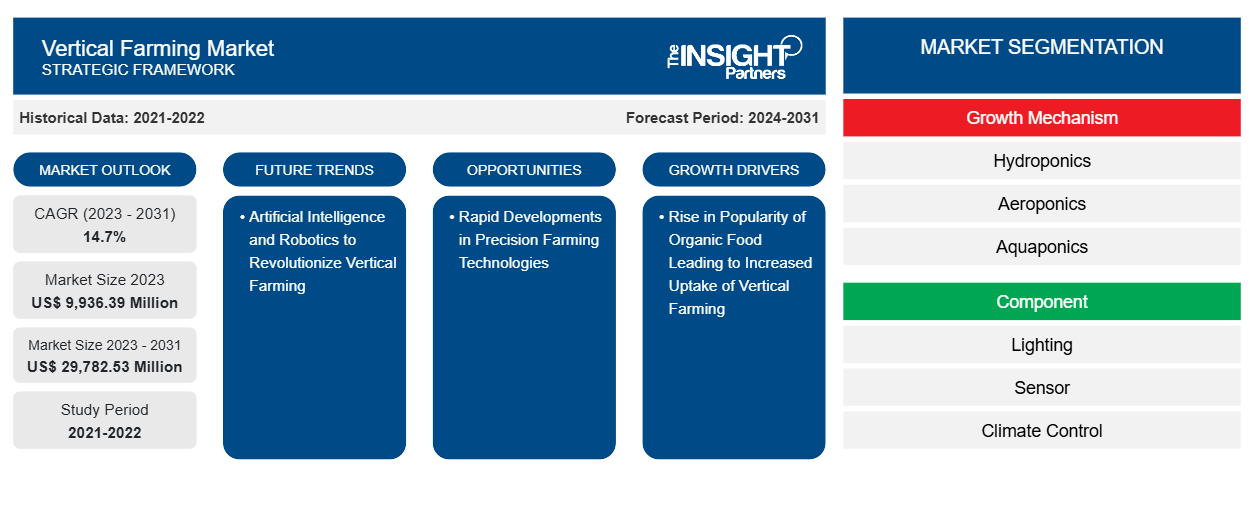Der Markt für vertikale Landwirtschaft wird voraussichtlich von 9.936,39 Millionen US-Dollar im Jahr 2023 auf 29.782,53 Millionen US-Dollar im Jahr 2031 anwachsen. Der Markt wird zwischen 2023 und 2031 voraussichtlich eine durchschnittliche jährliche Wachstumsrate von 14,7 % verzeichnen. Die steigende Nachfrage nach Bio-Lebensmitteln und die zunehmende Betonung der Präzisionslandwirtschaft dürften weiterhin ein wichtiger Trend auf dem Markt bleiben.
Marktanalyse für vertikale Landwirtschaft
Die wachsende Bevölkerung und das Bewusstsein der Verbraucher für gesunde Ernährung sind wichtige Treiber für die vertikale Landwirtschaft. Das wachsende Interesse an intelligenter und präziser Landwirtschaft wirkt sich auch weltweit positiv auf den vertikalen Landwirtschaftsmarkt aus. Mangelndes Bewusstsein und hohe Wartungskosten sind einige der Gründe, die das Wachstum des Marktes behindern könnten. Es wird jedoch erwartet, dass wachsende staatliche Initiativen für intelligente Landwirtschaftstechniken das Wachstum der vertikalen Landwirtschaft im Prognosezeitraum vorantreiben werden.
Marktübersicht Vertical Farming
Vertikale Landwirtschaft ist ein Verfahren, bei dem Nutzpflanzen vertikal angebaut oder gestapelt werden. Der gesamte Prozess wird in kontrollierten Umgebungen unter Verwendung von Methoden wie Hydroponik, Aeroponik und Aquaponik durchgeführt . Das Verfahren hilft dabei, Nutzpflanzen mit einer viel geringeren Wassermenge anzubauen als herkömmliche Anbaumethoden. Darüber hinaus reduziert vertikale Landwirtschaft auch den Bedarf an Pestiziden und anderen giftigen Pestiziden für den Anbau von Nutzpflanzen. Die zunehmende Urbanisierung und die wachsende Bevölkerung steigern den Bedarf an Nahrungsmitteln, was als Treiber für den Markt fungiert. Pharmaunternehmen konzentrieren sich auch auf vertikale Landwirtschaft in Innenräumen, um biomedizinische Pflanzen für Medikamente anzubauen, was ebenfalls einer der wichtigsten positiven Trends auf dem weltweiten Markt ist.
Passen Sie diesen Bericht Ihren Anforderungen an
Sie erhalten kostenlose Anpassungen an jedem Bericht, einschließlich Teilen dieses Berichts oder einer Analyse auf Länderebene, eines Excel-Datenpakets sowie tolle Angebote und Rabatte für Start-ups und Universitäten.
-
Holen Sie sich die wichtigsten Markttrends aus diesem Bericht.Dieses KOSTENLOSE Beispiel umfasst eine Datenanalyse von Markttrends bis hin zu Schätzungen und Prognosen.
Treiber und Chancen des Vertical Farming-Marktes
Steigende Beliebtheit von Bio-Lebensmitteln begünstigt den Markt
Das wachsende Gesundheitsbewusstsein und die Vorliebe für gesunde Lebensmittel sind die Haupttreiber für den Markt für vertikale Landwirtschaft. Verbraucher bevorzugen und zeigen Interesse am Verzehr von biologisch angebauten Produkten wie Obst, Gemüse und Getreide. Das zunehmende Gesundheitsbewusstsein ist einer der Hauptgründe für die wachsende Verbrauchernachfrage nach Lebensmitteln ohne schädliche künstliche Substanzen oder Chemikalien. Steigende Gesundheitsrisiken im Zusammenhang mit dem Verzehr von chemisch behandelten Pflanzen oder Gemüse sind ein wichtiger Treiber für Bio-Lebensmittel, was wiederum die Nachfrage nach vertikaler Landwirtschaft antreibt. Die wachsende Nachfrage nach unkonventionellen und biologisch angebauten Lebensmitteln das ganze Jahr über beeinflusst den Markt weltweit ebenfalls positiv.
Künstliche Intelligenz und Robotik verändern die vertikale Landwirtschaft
Der wachsende technologische Fortschritt in Bezug auf Prozessautomatisierung und Integration von Robotertechnologie dürfte dem Markt für vertikale Landwirtschaft große Chancen bieten. Die auf dem Markt tätigen landwirtschaftlichen Betriebe konzentrieren sich stärker auf Forschungs- und Entwicklungsaktivitäten, um künstliche Intelligenz einzuführen und die Wartung und Pflege von Pflanzen auf organisiertere und rationalisiertere Weise voranzutreiben. Darüber hinaus konzentrieren sich einige Unternehmen auch auf die Einführung von Robotern in der vertikalen Landwirtschaftsbranche, um menschliche Eingriffe zu reduzieren und die Zeiteffizienz zu steigern, was voraussichtlich auch das Wachstum des vertikalen Landwirtschaftsmarktes weltweit vorantreiben wird.
Segmentierungsanalyse des Marktberichts zur vertikalen Landwirtschaft
Wichtige Segmente, die zur Ableitung der Marktanalyse für vertikale Landwirtschaft beigetragen haben, sind Produktwachstumsmechanismen und -komponenten.
- Basierend auf dem Wachstumsmechanismus ist der Markt in Hydroponik, Aeroponik und Aquaponik unterteilt. Das Segment Hydroponik hatte im Jahr 2023 einen größeren Marktanteil.
- Nach Komponenten ist der Markt segmentiert in Beleuchtung, Sensoren, Klimatisierung, Bewässerungskomponenten, Baumaterialien und Sonstiges. Das Beleuchtungssegment hielt im Jahr 2023 einen erheblichen Marktanteil.
Marktanteilsanalyse für vertikale Landwirtschaft nach geografischer Lage
Der geografische Umfang des Marktberichts für vertikale Landwirtschaft ist hauptsächlich in fünf Regionen unterteilt: Nordamerika, Asien-Pazifik, Europa, Naher Osten und Afrika sowie Süd- und Mittelamerika.
Nordamerika ist Marktführer. Hohe Investitionen in fortschrittliche Technologien zur Steigerung der Lebensmittelproduktion und zur Erhöhung der Verfügbarkeit von saisonalem Obst und Gemüse das ganze Jahr über treiben die Nachfrage nach vertikaler Landwirtschaft in der Region Nordamerika an. Die wachsende Nachfrage nach unkonventionellem und biologisch angebautem Obst, Getreide und Gemüse fördert auch die Entwicklung des Marktes in Nordamerika. Temperaturschwankungen und wechselnde Wetterbedingungen sind wichtige Faktoren, die das Wachstum von Gemüse und Obst in verschiedenen Ländern behindern. Die Länder mit extremen Temperaturbedingungen treiben die Nachfrage nach vertikaler Landwirtschaft in Nordamerika an. Platzbeschränkungen werden auch durch die gestapelte, geschichtete Landwirtschaft ausgeglichen, was einer der Hauptgründe für die zunehmende Einführung vertikaler Landwirtschaftstechniken ist. Die zunehmende Einführung von Automatisierung und zunehmender Robotertechnologie im Agrarsektor wirkt sich ebenfalls positiv auf den vertikalen Landwirtschaftsmarkt in der Region aus. Die USA sind führend auf dem vertikalen Landwirtschaftsmarkt in Nordamerika.
Regionale Einblicke in den Vertical Farming-Markt
Die regionalen Trends und Faktoren, die den Vertical Farming-Markt im Prognosezeitraum beeinflussen, wurden von den Analysten von Insight Partners ausführlich erläutert. In diesem Abschnitt werden auch die Marktsegmente und die Geografie des Vertical Farming-Marktes in Nordamerika, Europa, im asiatisch-pazifischen Raum, im Nahen Osten und Afrika sowie in Süd- und Mittelamerika erörtert.

- Holen Sie sich die regionalen Daten für den Vertical Farming-Markt
Umfang des Marktberichts zur vertikalen Landwirtschaft
| Berichtsattribut | Details |
|---|---|
| Marktgröße im Jahr 2023 | 9.936,39 Millionen US-Dollar |
| Marktgröße bis 2031 | 29.782,53 Millionen US-Dollar |
| Globale CAGR (2023 - 2031) | 14,7 % |
| Historische Daten | 2021-2022 |
| Prognosezeitraum | 2024–2031 |
| Abgedeckte Segmente |
Nach Wachstumsmechanismus
|
| Abgedeckte Regionen und Länder |
Nordamerika
|
| Marktführer und wichtige Unternehmensprofile |
|
Dichte der Marktteilnehmer im Bereich Vertical Farming: Auswirkungen auf die Geschäftsdynamik verstehen
Der Markt für Vertical Farming wächst rasant, angetrieben durch die steigende Nachfrage der Endverbraucher aufgrund von Faktoren wie sich entwickelnden Verbraucherpräferenzen, technologischen Fortschritten und einem größeren Bewusstsein für die Vorteile des Produkts. Mit steigender Nachfrage erweitern Unternehmen ihr Angebot, entwickeln Innovationen, um die Bedürfnisse der Verbraucher zu erfüllen, und nutzen neue Trends, was das Marktwachstum weiter ankurbelt.
Die Marktteilnehmerdichte bezieht sich auf die Verteilung der Firmen oder Unternehmen, die in einem bestimmten Markt oder einer bestimmten Branche tätig sind. Sie gibt an, wie viele Wettbewerber (Marktteilnehmer) in einem bestimmten Marktraum im Verhältnis zu seiner Größe oder seinem gesamten Marktwert präsent sind.
Die wichtigsten auf dem Markt für vertikale Landwirtschaft tätigen Unternehmen sind:
- Eden Green Technologie
- Elevate Farms Inc.
- iFarm
- OSRAM GmbH
- Plenty Unlimited Inc.
- Himmelsgrün
Haftungsausschluss : Die oben aufgeführten Unternehmen sind nicht in einer bestimmten Reihenfolge aufgeführt.

- Überblick über die wichtigsten Akteure auf dem Vertical Farming-Markt
Neuigkeiten und aktuelle Entwicklungen zum Vertical Farming-Markt
Der Markt für vertikale Landwirtschaft wird durch die Erhebung qualitativer und quantitativer Daten nach Primär- und Sekundärforschung bewertet, die wichtige Unternehmensveröffentlichungen, Verbandsdaten und Datenbanken umfasst. Nachfolgend sind einige der Entwicklungen auf dem Markt für vertikale Landwirtschaft aufgeführt:
- Eden Green Technology sicherte sich 12 Millionen US-Dollar für seine Kombination aus vertikaler Farm und Gewächshaus. (Quelle: Eden Green Technology, Pressemitteilung, März 2024)
- Elevate Farms Inc. gab die Ausweitung seines vertikal angebauten Blattgemüse-Angebots in den USA und Europa bekannt. (Quelle: Elevate Farms Inc., Pressemitteilung, Februar 2024)
Marktbericht zum vertikalen Anbau: Abdeckung und Ergebnisse
Der Bericht „Vertical Farming Market Size and Forecast (2021–2031)“ bietet eine detaillierte Analyse des Marktes, die die folgenden Bereiche abdeckt:
- Marktgröße und Prognose für vertikale Landwirtschaft auf globaler, regionaler und Länderebene für alle wichtigen Marktsegmente, die im Rahmen des Projekts abgedeckt sind
- Markttrends und Marktdynamiken im Bereich Vertical Farming wie Treiber, Hemmnisse und wichtige Chancen
- Detaillierte PEST- und SWOT-Analyse
- Marktanalyse für vertikale Landwirtschaft mit wichtigen Markttrends, globalen und regionalen Rahmenbedingungen, wichtigen Akteuren, Vorschriften und aktuellen Marktentwicklungen
- Branchenlandschaft und Wettbewerbsanalyse, einschließlich Marktkonzentration, Heatmap-Analyse, prominenten Akteuren und aktuellen Entwicklungen für den Markt der vertikalen Landwirtschaft
- Detaillierte Firmenprofile
- Historische Analyse (2 Jahre), Basisjahr, Prognose (7 Jahre) mit CAGR
- PEST- und SWOT-Analyse
- Marktgröße Wert/Volumen – Global, Regional, Land
- Branchen- und Wettbewerbslandschaft
- Excel-Datensatz
Aktuelle Berichte
Erfahrungsberichte
Grund zum Kauf
- Fundierte Entscheidungsfindung
- Marktdynamik verstehen
- Wettbewerbsanalyse
- Kundeneinblicke
- Marktprognosen
- Risikominimierung
- Strategische Planung
- Investitionsbegründung
- Identifizierung neuer Märkte
- Verbesserung von Marketingstrategien
- Steigerung der Betriebseffizienz
- Anpassung an regulatorische Trends























 Kostenlose Probe anfordern für - Vertikaler Landwirtschaftsmarkt
Kostenlose Probe anfordern für - Vertikaler Landwirtschaftsmarkt